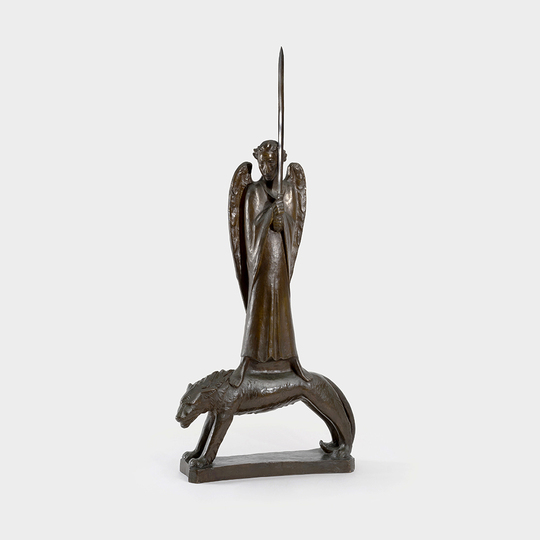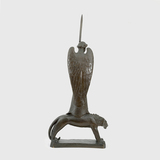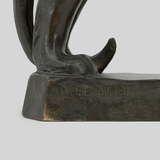Der Geistkämpfer
Ernst Barlach (Wedel/Holst. 1870 - Rostock 1938)

Lot-No. 328
Proceeds : 56.800 €
Designed 1928, made 1950s/60s or before. Bronze, brown patinated. H. 118,5 cm x w. 54 cm x d. 17 cm. On the back of the plinth signed below left: E. Barlach. A winged figure in a long robe stands on the back of a wolf-like animal; it holds a sword vertically. - Ernst Barlach conceived the Spiritual Warrior in 1928 as a large sculpture commissioned by Willy Hahn, the Kiel city building inspector. It was first installed at the University Church in Kiel and after its destruction in the Second World War at the Nicolai Church in Kiel. Barlach himself did not initially give the group a name; the title was suggested in the Kiel newspaper in 1928 and accepted by Barlach. The group does not represent a heroising monument. Although the spirit fighter refers to depictions of the archangel Michael fighting the dragon, Barlach does not show the angel as the victor who turns the sword against the beast, but as a calm, level-headed fighter who wins through reason and spirit. The large sculpture was demolished in 1937, initially stored in the Thaulow Museum and threatened to be melted down. The Barlach friend and art dealer Bernhard Böhmer transported it - sawn into four pieces - first to Berlin-Friedenau and finally to Schnega in the Lüneburg Heath, where it survived the Second World War on the estate of the Barlach confidant and artist Hugo Körtzinger. After the end of the war, the work was reinstalled at the Nicolai Church in Kiel. - Exhibitions: The bronze was exhibited: Nord-Kunst. Schleswig Holstein im 20. Jahrhundert, Nissen-Haus Husum, Sönderjyllands Kunstmuseum Tönder, Kulturforum Burgkloster Lübeck 2003/2004. - Literature: Laur (cat.rais. 428) mentions 12 unnumbered copies, 2 of which were cast in 1937 and 10 since 1938, some without foundry stamps (for example the copies in the Ernst Barlach Foundation Güstrow and in the Ernst Barlach Haus Hamburg) and with foundry stamps of the Hermann Noack foundry, Berlin; the bronze is published: Nord-Kunst. Schleswig Holstein im 20. Jahrhundert, exh.cat. 2003, fig. p.79 and text p. 379f. - German sculptor, writer and illustrator. B. studied 1888-95 at the Hamburg Kunstgewerbeschule and at the Dresden academy. He lived in Paris for two years before working as ceramicist in Hamburg, among others for the Altona manufactory Mutz. A journey to Russia became distinctive for his work. He first exhibited sculptures from Russian folk life at the Berlin secession in 1907. Subsequently he received many important public commissions. B. was very much pressurized by the Nazis, a. many of his works were seized or destroyed. Today he is appreciated as one of the most important sculptors of the 20th cent. Mus.: Hamburg (Ernst Barlach Haus), Nuremberg (Germanisches Nationalmuseum), Schwerin a. others. Lit.: Schult (cat. rais.) a. others.
Ernst Barlach: Der Geistkämpfer
Ernst Barlach (Wedel/Holst. 1870 - Rostock 1938)
Der Geistkämpfer
Lot-No. 328
Proceeds : 56.800 €
Designed 1928, made 1950s/60s or before. Bronze, brown patinated. H. 118,5 cm x w. 54 cm x d. 17 cm. On the back of the plinth signed below left: E. Barlach. A winged figure in a long robe stands on the back of a wolf-like animal; it holds a sword vertically. - Ernst Barlach conceived the Spiritual Warrior in 1928 as a large sculpture commissioned by Willy Hahn, the Kiel city building inspector. It was first installed at the University Church in Kiel and after its destruction in the Second World War at the Nicolai Church in Kiel. Barlach himself did not initially give the group a name; the title was suggested in the Kiel newspaper in 1928 and accepted by Barlach. The group does not represent a heroising monument. Although the spirit fighter refers to depictions of the archangel Michael fighting the dragon, Barlach does not show the angel as the victor who turns the sword against the beast, but as a calm, level-headed fighter who wins through reason and spirit. The large sculpture was demolished in 1937, initially stored in the Thaulow Museum and threatened to be melted down. The Barlach friend and art dealer Bernhard Böhmer transported it - sawn into four pieces - first to Berlin-Friedenau and finally to Schnega in the Lüneburg Heath, where it survived the Second World War on the estate of the Barlach confidant and artist Hugo Körtzinger. After the end of the war, the work was reinstalled at the Nicolai Church in Kiel. - Exhibitions: The bronze was exhibited: Nord-Kunst. Schleswig Holstein im 20. Jahrhundert, Nissen-Haus Husum, Sönderjyllands Kunstmuseum Tönder, Kulturforum Burgkloster Lübeck 2003/2004. - Literature: Laur (cat.rais. 428) mentions 12 unnumbered copies, 2 of which were cast in 1937 and 10 since 1938, some without foundry stamps (for example the copies in the Ernst Barlach Foundation Güstrow and in the Ernst Barlach Haus Hamburg) and with foundry stamps of the Hermann Noack foundry, Berlin; the bronze is published: Nord-Kunst. Schleswig Holstein im 20. Jahrhundert, exh.cat. 2003, fig. p.79 and text p. 379f. - German sculptor, writer and illustrator. B. studied 1888-95 at the Hamburg Kunstgewerbeschule and at the Dresden academy. He lived in Paris for two years before working as ceramicist in Hamburg, among others for the Altona manufactory Mutz. A journey to Russia became distinctive for his work. He first exhibited sculptures from Russian folk life at the Berlin secession in 1907. Subsequently he received many important public commissions. B. was very much pressurized by the Nazis, a. many of his works were seized or destroyed. Today he is appreciated as one of the most important sculptors of the 20th cent. Mus.: Hamburg (Ernst Barlach Haus), Nuremberg (Germanisches Nationalmuseum), Schwerin a. others. Lit.: Schult (cat. rais.) a. others.






